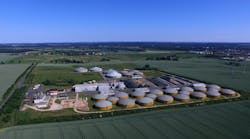A new report from Bates White Economic Consulting predicts that both supply and demand for renewable natural gas (RNG) in the U.S. transportation sector will grow rapidly over the next five years.
The report said the use of RNG in transportation grew to more than 300 million ethanol gallon equivalents last year, due in part to the federal Renewable Fuel Standard. The Coalition for Renewable Natural Gas (RNG Coalition) presented the report to the U.S. Environmental Protection Agency and White House Office of Management and Budget during a meeting earlier this month.
“Renewable natural gas production more than doubled from 2015 through 2018 under the Renewable Fuel Standard, growing by an annual average of 30%,” said Johannes Escudero, RNG Coalition CEO. “Keeping up this recent rate of growth, the RNG industry would reach 1 billion gallons of annual production of RNG transportation fuel in 2022.”
As of April, there were 96 operating RNG projects and 61 RNG projects under construction or in advanced development. Since 2015, the number of companies developing RNG projects grew from 15 to more than 50.
Total capital costs for RNG projects landfill projects are in the range of $5 million to $25 million, and upwards of $100 million for larger ones, such as agricultural and wastewater projects.
David Cox, director of operations for the RNG Coalition, pointed out that the growth of RNG “means local construction jobs, ongoing operations and engineering jobs, and millions of dollars invested in communities across the country."
The report noted that RNG availability has already enhanced the economic value associated with converting trucks from diesel, and promoted investments in compressed natural gas and liquified natural gas infrastructure. It also said natural gas use in transportation is growing because it is increasingly economic, especially for medium- and heavy-duty vehicles like refuse trucks, parcel carriers and over-the-road trucks.
“RNG is distributed on existing natural gas pipelines and local distribution systems, allowing it to easily reach end-use customers,” the report stated. RNG also provides up to an 85% reduction of carbon dioxide emissions relative to diesel fuel, according to an analysis from Argonne National Labs referenced in the report from Bates White.



